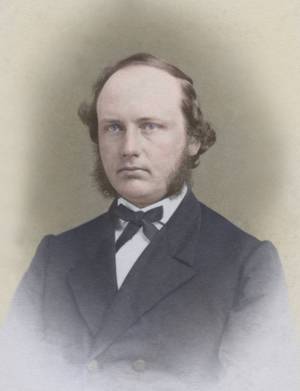Rasmus Malling-Hansen - Timeline
1835: Born in Hunseby, Denmark, as the first son of Johan Frederik Hansen and Juliane Hansen, born Matzen
1839: His father dies of typhoid fever, and the mother and her Three sons moves in with schoolteacher Rasmus Malling's family, and he becomes the boys' fosterfather
1850: Confirmation in Hunseby
1850-52: Trained to be a painter
1852-54: Student at the Jonstrup Teachers seminarium
1854-55: Teacher in Maglemer old school, Hunseby and private teacher at Knuthenborg and in the home of the minister in Hunseby
1855-58: Own studies
1858-59: Student of theology at the University in Copenhagen
1859-61: Teacher at the Royal Institute for the deaf-mutes in Copenhagen
1861-62: Student - theology
1862-64: Teacher and later headmaster at the Royal Institute for the deaf-mutes in Schlesvig
1865: Final University examination
Married to Cathrine Georgia Heiberg, 1841-1876
Experimenting with the placement of the letters on a keyboard made of
porselaine
1865-90: Principal at the Royal Institute for the deaf-mutes in Copenhagen
1866: First daughter: Juliane
1867: The official date of the invention of the writing ball. Probably it was the
table model that was built as the first specimen.
1868: Second daughter: Engelke
Went on a study tour around Europe to make researches about
new methods and ways of organizing the teaching of the deaf
1869: Third daughter: Emma
According to some sources the writing ball was exhibited in Altona either
in the official exhibition or in the locals of a bussiness associale.
1870: Fourth daughter: Zarah
First patent on the writing ball. Presentation of the box model to the press
in Denmark.
1871: New models of the writig ball: Open model with cylinder and ditto with flat
flat carriage.
The writing ball was exhibited at the South Kensington Exhibition in London.
1872: Invention of the Takygraf and the Xerografi
First prize medal at the Scandinavian exhibition in Copenhagen
Danish merit medal in gold for the invention of the writing ball
1873: Fifth daughter: Johanne
The Vortschritts medal - first prize at the World Exhibition in Vienna
Austrian Goldmedal "pro literus et artibus"
1874: Sixth daughter: Karen
1875: Seventh daughter: Marie
New model of the writing ball; the tall model without an electromagnetic
battery
Participated at the Yorkshire Exhibition in Leeds
1876: The death of his first wife: Cathrine Georgia Heiberg
Knight of the Swedish Vasa order
Elected as chairman on a large Internordic School Meeting in
Copenhagen
First prize medal at the Centennial Exhibition in Philadelphia.
1877: Starts a project of systematicly measurings of the hight of a group of children at the Institute to check if their fysical development is satisfactory
1878: New model of the writing ball; now with a colour ribbon
First prize medal at the World exhibition in Paris
1880: Marriage to his second wife; Anna, born Steenstrup(1842-1897)
Knight of the Danebrog, Denmark
New model of the writing ball - developed by the mecanic Lyngbye - now
with a paper platen.
1882-1883: Systematicly weighings on large weights several times every day of a large group of children at the Institute, to do researches about the development of their weight.
1883: Published the first report from his studies of the growth and encrease in weight of children, called Fragment I: Om Periodicitet af Børns Vægt.
1884: Lecture at an international science congress in Copenhagen, about the variations in the growth of children. Publication of Fragment II:
T ä g l i c h e W ä g u n g e n der 130 Zöglingedes Königlichen Taubstummen-Instituts in Kopenhagen.
1886: Publication of his book on the same topic, called Fragment III in Danish and German: Periods in Children´s Weight and the Heat of the Sun
1888: Receives the first prize medal at the Art and Industry exhibition in Copenhagen
Member and secretary of a public commettee - writes the final proposals of the commettee, concerning the organization of the teacing of the deaf-mutes in Denmark
1890: Seriously ill from a heart desease
1890: Lecture at an internordic teachers conference in Copenhagen about the development of the teaching of the deaf mutes
1890: Speech at the 100 years anniversary of the Jonstrup tachers seminar
1890: Dies of a heart attack
Oslo, 26.11.06
Sverre Avnskog

